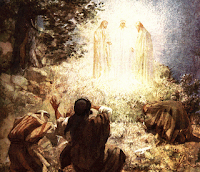Lectionary Reflections
Six days later Jesus took Peter and the two brothers, James and John, and led them up a high mountain to be alone. As the men watched, Jesus’ appearance was transformed so that his face shone like the sun, and his clothes became as white as light. Suddenly, Moses and Elijah appeared and began talking with Jesus.
Peter exclaimed, “Lord, it’s wonderful for us to be here! If you want, I’ll make three shelters as memorials—one for you, one for Moses, and one for Elijah.”
But even as he spoke, a bright cloud overshadowed them, and a voice from the cloud said, “This is my dearly loved Son, who brings me great joy. Listen to him.” The disciples were terrified and fell face down on the ground.
Then Jesus came over and touched them. “Get up,” he said. “Don’t be afraid.” And when they looked up, Moses and Elijah were gone, and they saw only Jesus.
As they went back down the mountain, Jesus commanded them, “Don’t tell anyone what you have seen until the Son of Man has been raised from the dead.”
The Transfiguration of Jesus. I’m sure you have all heard the stories, sermons, or homilies Sunday on this passage. I’m certain there was talk about ‘mountain top experiences’ and how we can’t live on the mountain top. But I would say that, while it is certainly true that we can’t always live in those mountain top experiences, those experiences can carry us through the valleys. And I think this passage shows us just that.
One of the things that some people don’t see is the symbolism in this passage. Moses and Elijah would be seen as ‘The Law and the Prophets’ or the Old Covenantal System and the transfigured Jesus as the New Covenantal System. We could say, Moses and Elijah represented the Old Way and the transfigured Jesus, the New Way. What we have, then, would be the removal of the Old Way to make room for the New Way. This isn’t meaning that the Old Way was wrong or inferior or whatever. It just means that, to go forward, to be able to handle the challenges that will be faced, a New Way needs to be born. This New Way is not something altogether foreign. No. It is based off of and built upon the Old Way. Just as one needs a firm grasp of elementary subtraction before one can handle working with negative numbers*, the Old Way was necessary to make people ready for the New Way.
Notice the scene. Peter, James, and John see the Moses and Elijah standing with and talking to the transformed Jesus. They were talking about the ‘exodus’ (Luke 9 - more on that in a moment). When Pete states that he wants to build shrines there, the Voice tells him to pay attention only to Jesus. And to drive the point home, when Pete and the Thunder Boys are brought to their feet, only Jesus remains. I’m positive they would have gotten the message (and even more so when the Temple was destroyed roughly 40 years later). Sometimes (almost all of the time), to go forward, we have to leave behind our former way of seeing.
From this point forward in the story, we see Peter struggling with this transition. Over and over he tries to hold on to the Old Way (think of his violent outburst when Jesus was arrested) and is struck with the New Way (think Jesus’ rebuke of that violent scene).
But after the resurrection and ascension, Peter changed. Oh sure, he struggled now and then with the New Way (see Galatians 2.11ff), but by and large, he was squarely about this New Way. He set about looking for places to implement this New Way. He, and the other Apostles, were leading people on a New Exodus - leading them out of one way of being to a New Way of being. He was the first one of the Apostles who ministered to Gentiles, i.e., of seeing the image of God in Others. According to tradition, he was the first pope of the Roman Church. And, the Gospel of Mark is said (by some) to be based on Peter’s stories.
But, even all of this, we catch a glimpse that Peter’s ‘mountain top’ experience was still with him much later in his life. In the Second Letter attributed to Peter, it is written:
[We] were not making up clever stories when we told you about the powerful coming of our Lord Jesus Christ. We saw his majestic splendor with our own eyes when he received honor and glory from God the Father. The voice from the majestic glory of God said to him, “This is my dearly loved Son, who brings me great joy.” We ourselves heard that voice from heaven when we were with him on the holy mountain.
He goes on to say that, because of that experience, he is more confident about what God is doing through them; about where God is leading them.
This New Exodus is still going on today. More and more of us are being set free from bondage (from sin and death, blindness and injustice, etc.) and going out to find new ways of living with our new found freedom. We are looking for way of implementing the Reign of God in our daily lives.
As we are on the cusp of entering the Lenten season, let us remember this. May God be gracious upon us and give us that mountain top experience so that we, too, can be prepared to move forward wherever the Wild Goose leads us.
~~~
* See A New Kind of Christianity by Brian McLaren.
~~~
In the Love of the Three in One,
Jack+, LC



Comments